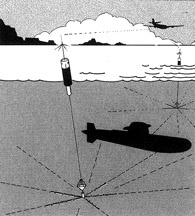
Barra Sonobuoy sonar
1980
submarine detection and surveillance system
'Dive, dive, dive!' In World War I, submarines had a dramatic effect on navy battles because ships had no way of detecting them. By World War II, sonar systems had begun to solve the problem. Sonar is a way of detecting things underwater. It usually involves sending out sound pulses which bounce off objects and echo back to you (also called 'echo location').
The Defence Science and Technology Organisation began designing the Barra Sonobuoy in 1964 to improve the Royal Australian Navy's ability to hunt subs. The Sonobuoy is dropped from an aircraft into the sea. Part of it sinks and unfolds into an array of hydrophones (underwater microphones).
The hydrophones don't send out sonar signals and pick up the echoes. They actually listen for the sounds made by submarines. The array is connected to a radio transmitter in a buoy floating on the surface.
Aircraft collect the signals from several Sonobuoys and analyse the information with a signal processor developed by defence scientists in Britain. The information helps tacticians to pinpoint the sub's location and to decide if it's a friend or foe. Unfortunately the cost of recovering the buoys is high, and they eventually sink to the bottom of the sea.
Barra Sonobuoys entered active service in 1980. Since then over 30 000 have been made, earning Australia over $200 million in exports.
Who Did It?
Key Organisations
Thomson Marconi Sonar : manufacture 1995-2001
Sonobuoys Australia : manufacture 1987-1995
Amalgamated Wireless Australia Pty Ltd : manufacture 1978-87
Defence Science and Technology Organisation : system design
Key People
Henry d'Assumpcao : research team leader
W A S Butement : concept
Further Reading
Dictionary of Australian inventions and discoveries
Margaret McPhee
Allen & Unwin, Sydney, 1993, pp 12-13.
Links
Defence Science and
Technology Organisation
Thomson Marconi Sonar
WiNRADiO Communications
|











